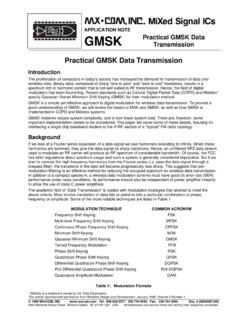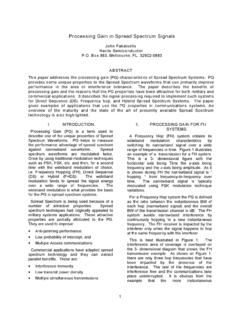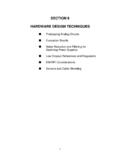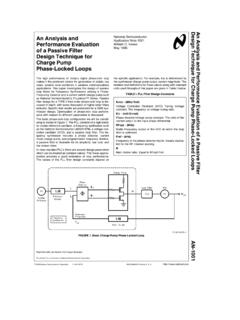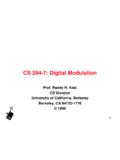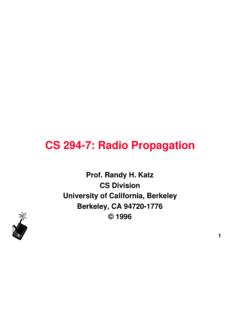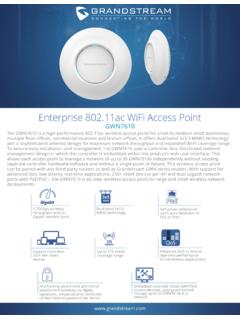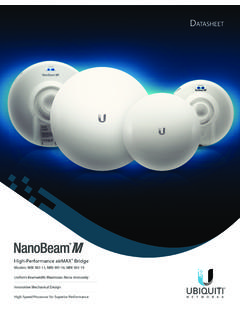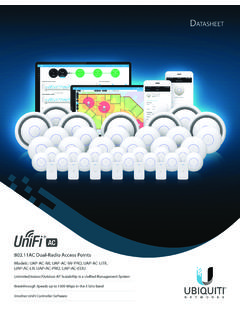Transcription of IEEE 802.11g Document - Spread spectrum
1 ieee New Draft Standard Clarifies Future of wireless LAN Users to benefit from higher data rates, extended reach and backward compatibility with , plus forward compatibility to William Carney Marketing Manager wireless Networking Business Unit, Texas Instruments Introduction Prior to the recent selection of the ieee draft standard for wireless local area networks (WLANs) operating up to 54 megabits per second (Mbps) in the gigahertz (GHz) band, the market was served by two non-compatible specifications, and Faced with market availability of both products in late 2001, some end users were potentially confused about which technology would evolve to meet their future needs, and some networking manufacturers were unsure about which specification would be best to direct their developmental efforts.
2 There is much to be understood about the new draft standard, including its history, specifications and implications in the WLAN market, but this much is certain: it combines the best of the existing and standards, and promises a harmonized future that will encourage continued and rapid market development in WLANs. In addition, users will benefit from higher data rates, extended range and compatibility with already installed Wi-Fi devices. Where did come from? The first wireless Ethernet standard, ieee , was adopted in 1997. This standard provided for three physical layer (PHY) specifications including infrared, 1-2 Mbps frequency hopping Spread spectrum (FHSS) and 1-2 Mbps direct sequence Spread spectrum (DSSS) in the GHz ISM band.
3 Because wired Ethernet LANs at the time were capable of speeds up to 10 Mbps and early products were quite pricey, the original standard had limited success in the market. Two years later, the original standard evolved along two paths. The specification increased data rates well beyond the critical 10 Mbps mark, maintained compatibility with the original DSSS standard and incorporated a more efficient coding scheme known as complimentary code keying (CCK) to attain a top-end data rate of 11 Mbps. A second coding scheme, Packet Binary Convolutional Code (PBCC ), was included as an option for higher performance in the form of range at the and 11 Mpbs rates, as it provided for a 3 decibel (dB) ieee Draft Standard Clarifies Future of wireless LAN 2 2002 Texas Instruments Incorporated coding gain.
4 The second offshoot of was designated as It ventured into a different frequency band, the GHz U-NII band, and was specified to achieve data rates up to 54 Mbps. Unlike , which is a single carrier system, utilized a multi-carrier modulation technique known as orthogonal frequency division multiplexing (OFDM). By utilizing the GHz radio spectrum , is not interoperable with either , or the initial WLAN standard. In March 2000, the ieee Working Group formed a study group to explore the feasibility of establishing an extension to the standard for higher data rates greater than 20 Mbps.
5 In July 2000, this study group became a full task group, Task Group G (TGg), with a mission to define the next standard for higher rates in the GHz band. For the past year and a half, TGg reviewed potential technical solutions for the new standard, with the field of candidates being narrowed to two final proposals in the May 2001 meeting. At this meeting, TI s proposal called PBCC-22, offering 22 Mbps operation in the GHz band and seamless compatibility with existing Wi-Fi devices, was eliminated from consideration under the selection criteria being used by the group.
6 However, the remaining proposal from Intersil Corporation, CCK-OFDM, proposed to make use of OFDM modulation to attain higher rates, failed to achieve the necessary 75 percent approval in order to become the selected technology for the new standard. TI continued to support the standards process, contributing compromise proposals to the TGg through the November 2001 meeting. As of the third day of the November 2001 ieee meeting, Intersil s CCK-OFDM proposal appeared to be headed for uncertainty, having received only 55 percent acceptance of the required 75 percent to become the draft standard at the first-round vote.
7 At this point, members considered the very real possibility of discontinuing the entire effort, versus finding a common ground and consensus-oriented solution that would be agreeable to the majority of the task group. On November 15, a compromise proposal that combined elements of both TI and Intersil s original proposals, became the draft standard with percent of members voting in favor of it. What's in The draft standard utilizes existing elements from the original CCK-ODFM and PBCC-22 proposals. Each of these proposals called for true OFDM operation in the GHz band as an optional mode to the primary proposed modulation, either CCK-OFDM or PBCC-22.
8 The draft standard makes OFDM the mandatory technology, offering data rates in the GHz band, requires mandatory implementation of modes and offers optional modes of CCK-OFDM and PBCC-22. This balanced compromise offers a much clearer bridge between and , plus is a straightforward means to develop true multi-mode WLAN products. achieves the high 54 Mbps data rates (Table 1, Appendix, page 5) of in the GHz band, thereby ieee Draft Standard Clarifies Future of wireless LAN 3 2002 Texas Instruments Incorporated maintaining compatibility with installed equipment.
9 Figure 1 (page 5) demonstrates that the performance of , in terms of both data transfer speeds and range, is better than any of the alternatives that had been considered earlier in the selection process. Issues Raised Since the selection of the draft standard technology, some observers have questioned the merits of continuing development activity in the GHz band. The reasoning has predominantly cited the increased crowding of this spectrum , versus that of the relatively clearer GHz spectrum utilized by Certainly the past performance of already-installed networks provides evidence that the GHz band is well suited to wireless networking and the devices have continued to provide excellent performance in the presence of increasing interference.
10 In addition, the GHz ISM band is available throughout the world with relatively few, if any, regulatory restrictions. In contrast, the GHz band is used by military applications such as high-energy radar and, as a result, several major global markets, including Western Europe and Japan, have to date placed regulatory restrictions on the commercial use of this band. Even in the United States there are questions concerning security risks for military operations with operating in the GHz band. Utilizing the GHz band ensures that WLANs will avoid the regulatory restrictions that are likely to be encountered, while offering backwards compatibility with systems.
